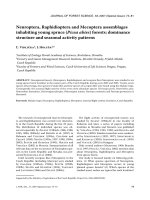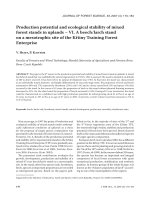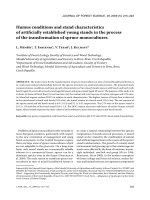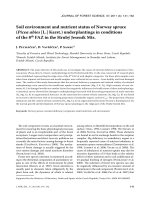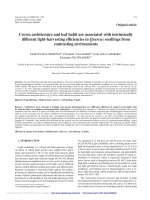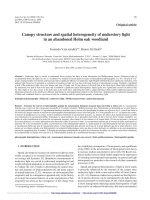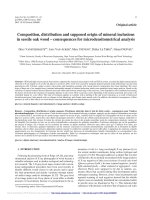Báo cáo lâm nghiệp: "Stomatal conductance and xylem-sap abscisic acid (ABA) in adult oak trees" pdf
Bạn đang xem bản rút gọn của tài liệu. Xem và tải ngay bản đầy đủ của tài liệu tại đây (791.86 KB, 14 trang )
Original
article
Stomatal
conductance
and
xylem-sap
abscisic
acid
(ABA)
in
adult
oak
trees
during
a
gradually
imposed
drought
MB
Triboulot
ML
Fauveau
N
Bréda
P Label
E
Dreyer
1
Équipe
bioclimatologie
et
écophysiologie,
unité
d’écophysiologie
forestière,
Centre
de
Nancy,
Inra,
54280
Champenoux;
2
Unité
physiologie
du
développement,
laboratoire
d’amélioration
des
arbres
forestiers,
Centre
d’Orléans,
Inra,
45160
Olivet,
France
(Received
18
October
1994;
accepted
19
June
1995)
Summary —
Thirty-
to
40-year-old
oak
trees
(Quercus
petraea
Matt
Liebl
and
Q
robur
L)
growing
in
a
forest
stand
near
Champenoux
(Nancy,
France)
were
submitted
to
an
imposed
drought
in
a
lysime-
ter
during
two
successive
summers.
Xylem
sap
was
extracted
from
leafy
twigs
of
two
trees
per
species
at
regular
intervals
during
the
onset
of
drought,
and
of
two
controls
in
parallel.
Predawn
leaf
water
potential,
soil
water
potential
at
different
depths
and
midday
stomatal
conductance
of
sun-exposed
leaves
were
recorded
at
the
same
pace.
Concentrations
of
abscisic
acid
(ABA)
and
of
the
glucose
ester
of
ABA
(ABA-GE)
were
measured
with
an
ELISA
technique,
after
purification
of
the
sap
samples
using
high
per-
formance
liquid
chromatography
(HPLC).
Mean
concentrations
of
ABA
recorded
in
the
absence
of
drought
constraint
were
around
30
μmol
m
-3
,
independently
from
year
and
species,
and
45
μmol
m
-3
for
ABA-GE.
No
significant
drought-related
increase
in
either
of
these
concentrations
could
be
recorded
while
predawn
leaf
water
potential
dropped
below-1.5
MPa,
and
stomatal
conductance
down
to
10%
of
the
values
of
controls.
A
good
correlation
between
stomatal
conductance
and
predawn
leaf
water
potential
was
detected,
and
even a
better
one
between
stomatal
conductance
and
soil
water
potential
at
25
cm.
It
may
be
concluded
from
these
results
that,
even
if
a
close
correlation
exists
between
stom-
atal
aperture
and
soil
moisture,
the
existence
of
a
root
signalling
process
based
solely
on
increased
ABA
*
Correspondence
and
reprints:
Abbreviations:
ABA:
abscisic
acid;
ABA-GE:
glucose
ester
of
abscisic
acid;
MeABA:
methyl
ester
of
ABA;
ABA
xy
and
ABA-GE
xyl
:
concentrations
of,
respectively,
ABA
and
ABA-GE
in
the
xylem
sap
(μmol
m
-3);
Q
ext
:
volume
of
xylem
sap
extracted
from
the
twigs
(μL);
BSA:
bovine
serum
albumin;
ELISA:
enzyme-linked
immunosorbent
assay;
gs:
stomatal
conductance
(mmol
m
-2
s
-1);
Ψ
wp
:
predawn
leaf
water
potential
(MPa).
or
ABA-GE
transport
in
the
xylem
sap
may
be
questioned.
Stomatal
conductance
under
natural
con-
ditions
is
probably
controlled
by
a
rather
complex
chain
of
processes
which
has
still
to
be
elucidated.
ABA
/
ABA-GE
/
drought
/
stomatal
conductance
/
water
stress
/
xylem
sap
/
Quercus
robur /
Quer-
cus
petraea
Résumé —
Conductance
stomatique
et
acide
abscissique
dans
la
sève
brute
de
chênes
adultes
au
cours
d’une
sécheresse.
Des
chênes
âgés
de
30
à
40
ans
appartenant
aux
deux
espèces
pédon-
culé
et
sessile
(Quercus
robur
L
et
Q
petraea
Matt
Liebl)
ont
été
sélectionnés
dans
un
haut
perchis
de
la
forêt
domaniale
de
Champenoux
(Nancy,
France),
et
soumis
à
une
sécheresse
contrôlée
dans
une
cuve
lysimétrique
au
cours
de
deux
étés
successifs.
De
la
sève
brute
a
été
extraite
du
xylème
de
rameaux
feuillés
à
intervalles
de
temps
réguliers
pendant
l’installation
de
la
sécheresse,
et
sur
des
arbres
témoins.
Le
potentiel
hydrique
de
base,
le
potentiel
hydrique
du
sol
à
différentes
profondeurs
et
la
conductance
stomatique
en
milieu
de journée
ont
été
relevés
sur
les
mêmes
arbres.
Les
concentrations
en
acide
abscissique
(ABA)
et
en
glucose-ester
d’ABA
(ABA-GE)
ont
été
déterminées
dans
ces
échan-
tillons
de
sève
à
l’aide
d’un
dosage
Elisa,
après
purification
par
HPLC.
En
l’absence
de
sécheresse,
les
concentrations
moyennes
en
ABA
étaient
de
l’ordre
de
30
μmol
m
-3
,
et
de
45
μmol
m
-3
pour
l’ABA-GE.
Ces
concentrations
étaient
indépendantes
de
l’espèce
et
de
l’année
de
mesure ;
seules
les
concentrations
en
ABA-GE
ont
fortement
augmenté
d’une
année
sur
l’autre.
Aucune
augmentation
signi-
ficative
due
à
la
sécheresse
n’a
pu
être
détectée,
bien
que
les
potentiels
hydriques
de base
aient
chuté jusqu’à
des
valeurs
inférieures
à
-1,5
MPa,
et
que
la
conductance
stomatique
ait
été
réduite
à
10
%
des
valeurs
initiales
dans
certains
cas.
Une
bonne
corrélation
entre
conductance
stomatique
et
potentiel
hydrique
de
base
a
pu
être
mise
en
évidence.
Cette
corrélation
a
été
améliorée
en
utilisant
les
valeurs
de
potentiel
hydrique
de
sol
à
25
cm
de
profondeur.
Nous
concluons
que,
même
si
une
bonne
corrélation
existe
entre
conductance
stomatique
et
humidité
du
sol,
l’existence
d’un
signal
racinaire
sous
la
forme
exclusive
d’un
transport
d’ABA
ou
d’ABA-GE
des
racines
vers
les
couronnes
est
peu
probable.
La conductance
stomatique
de
chênes
de
grande
taille
poussant
en
conditions
naturelles
est
vrai-
semblablement
contrôlée
par
un
processus
complexe
qui
reste
à
préciser.
ABA
/ ASA-GE / sécheresse
/ conductance
stomatique / stress
hydrique / sève
brute / Quercus
robur
/Quercus
petraea
INTRODUCTION
Oak
trees
frequently
suffer
from
drought-
induced dieback
(Landmann
et
al,
1993).
Intensive
studies
on
water
relations
of
30-
year-old
oak
trees
in
a
stand
near
Nancy,
France,
have
shown
that
the
two
European
species
(Quercus
robur
L and
Q
petraea
Matt
Liebl)
were
rather
drought
tolerant,
due
to
a
deep
and
efficient
rooting
system
(Bréda
et
al,
1995b),
associated
with
a
low
sensitivity
to
cavitation
in
the
xylem
con-
duits
(Cochard
et
al,
1992),
and
the
main-
tenance
of
substantial
transpiration
rates
and
open
stomata
till
rather
low
soil
mois-
ture
(Bréda
et
al,
1993a,b;
Epron
and
Dreyer, 1993).
The
question
therefore
arose
of
the
factors
controlling
stomatal
opening
in
these
trees,
and
whether
root-issued
abscisic
acid
(ABA)
was
involved
in
this
control.
Much
accumulated
evidence
suggests
that
stomatal
closure
during
drought
may
be
triggered
by
a
nonhydraulic
signal
origi-
nating
from
the
roots
exposed
to
drying
soils
(see
reviews
by
Davies
and
Zhang,
1991;
and
Davies
et
al,
1994).
ABA
is
the
most
frequently
suggested
chemical
effector
thought
to
be
released
from
drying
roots,
and
transported
via
the
transpiration
stream
in
the
xylem
to
the
apoplastic
spaces
in
the
leaves
where
it
interacts
with
the
guard
cells
and
induces
stomatal
closure
(Davies
et
al,
1994).
Actually,
ABA
concentrations
in
xylem
and
in
apoplastic
sap
have
been
shown
to
increase
with
soil
water
depletion
in
many
plant
species
including
trees
(Scuiller,
1990;
Wartinger et al,
1990;
Har-
tung
and
Slovik,
1991;
Khalil
and
Grace,
1993),
and
to
correlate rather
well
with
stom-
atal
conductance
in
many
cases
(Tardieu
and
Davies,
1992;
Khalil
and
Grace,
1993;
Correia
and
Pereira,
1994).
Nevertheless,
the
relationship
was
very
diverse,
leading
to
the
assumption
that
the
stomatal
sensi-
tivity
to
xylem
ABA
could
vary
among
species,
and
in
a
given
species
in
relation
to
other
physiological
parameters,
such
as
leaf
water
status
(Tardieu
and
Davies,
1992)
or
chemical
composition
of
the
xylem
sap
(Schurr et al,
1992).
Despite
this
evidence,
there
is
still
some
discussion
about
the
quantitative
implica-
tion
of
root-issued
ABA
in
the
control
of
stomatal
conductance.
In
particular,
data
obtained
on
adult
trees,
where
a
long
dis-
tance
transport
of
root-issued
ABA
is
required,
are
still
scarce
(Wartinger
et
al,
1990).
Moreover,
most
ABA
data
have
been
obtained
from
unpurified
sap
samples
with
an
ELISA
test,
which
does
not
accurately
detect
combined
ABA
such
as
the
glucose
ester
(ABA-GE)
that
might
play
an
impor-
tant
role
as
a
transport
form.
To
test
if
drought
promoted
significant
increases
in
the
concentrations
of
both
forms
of
ABA
in
relation
to
stomatal
closure,
we
collected
xylem
sap
during
two
successive
summers
(1992
and
1993)
on
oak
trees
in
an
experi-
mental
field
plot
submitted
to
a
gradual
soil
water
depletion,
and
quantitated
ABA
using
high
performance
liquid
chromatography
(HPLC)
purification
and
ELISA
detection
(Label
et
al,
1994).
It
has
often
been
argued
that
root
signalling
could
allow
an
adequate
stomatal
response
to
the
desiccation
of
the
upper
soil
levels
where
rooting
is
dense
while
deeper
layers
remain
humid
(Davies
and
Zhang,
1991).
To
verify
this
hypothe-
sis,
we
tested
for
correlations
between
soil
water
potential
at
several
depths
in
the
soil
and
stomatal
conductance
of
sun-exposed
leaves.
MATERIALS
AND
METHODS
Experimental
design
The
experiment
was
conducted
during
the
sum-
mers
of
1992
and
1993
in
an
oak
forest
at
Cham-
penoux
near
Nancy,
northeastern
France,
on
30-
year-old
and
approximatively
18 m
high
trees.
Four
dominant
trees
(two
Quercus
roburand
two
Quercus
petraea)
were
selected
in
a
group
of
17
trees
included
in
a
water-stressed
plot.
An
artificial
drought
was
applied:
rain
and
throughfall
were
prevented
by
a
plastic
roof
built
under
the
canopy
and
lateral
drainage
was
removed
in
1
m
deep
trenches.
The
roof
was
installed
before
bud-break,
at
the
end
of
February
1992,
and
trees
depleted
gradually
the
extractable
soil
water.
During
1992,
a
heavy
thunderstorm
promoted
an
uncontrolled
rewatering
on
d266.
Four
other
trees
were
chosen
as
controls.
They
were
watered
manually
during
the
measurement
period
in
1992,
and
experi-
enced
natural
water
balance
during
1993.
Dur-
ing
1993,
sap
collection
was
restricted
to
two
stressed
and
two
control
trees
of
Q
petraea.
For
additional
details
about
the
experimental
design,
see
Bréda
et
al
(1993a).
Climate
was
recorded
with
a
weather
station
installed
above
the
canopy,
yielding
global
radiation,
air
temperature,
wind
speed
and
vapour
pressure
deficits
at
a
half-hourly
pace.
Stomatal
conductance
(g
s)
was
recorded
with
a
steady-state
porometer
(LI-1600,
LI-Cor,
Lincoln,
NE,
USA)
during
bright
sunny
days.
Mea-
surements
were
made
between
12
and
14
PM
UT
on
ten
sun-exposed
leaves
of
the
upper
canopy
of
each
tree.
Predawn
leaf
water
potential
(Ψ
wp
,
two
replicates
per
tree)
was
measured
on
the
same
days
with
a
Scholander
pressure
cham-
ber.
Soil
water
potential
at
25,
50,
80,
110
and
140
cm
depth
was
recorded
with
soil
psychrom-
eters
(Wescor
HR
33T).
To
avoid
artefacts
due
to
uncontrolled
soil
rehydration,
we
restricted
the
analysis
of
the
relationships
between
soil
water
and
stomatal
conductance
to
trees
grown
in
the
lysimeter,
and
to
the
period
of
onset
of
drought
(Q
petraea
and
Q
robur,
1992
and
1993).
Extraction of
xylem
sap
Immediately
after
the
measurements
of
stomatal
conductance,
one
extraction
was
made
per
tree
(two
per
treatment).
A
20
to
30
cm
long
twig
with
four
to
ten
leaves
was
cut
off
the
upper
crown
and
rapidly
enclosed
into
a
Scholander
pressure
chamber.
The
bark
was
removed
from
the
distal
end
to
avoid
pollution
of
xylem
sap
by
ABA
exud-
ing
from
phloem
tissues
(Else
et
al,
1994).
Fifty
to
400
μL
(measured
by
differential
weighing
of
the
vials
before
and
after
collection)
were
sampled
by
pressurising
the
twigs
at
about
0.5
MPa
above
the
balancing
pressure.
The
sap
was
absorbed
directly
from
exuding
vessels
with
a
micropipette:
sap
droplets
were
absorbed
as
soon
as
they
appeared
to
minimize
evaporation.
The
samples
were
immediately
deep-frozen
in
liquid
nitrogen
and
stored
at
-20
°C
for
later
analysis.
Purification
of xylem
sap
Tritiated
ABA
(2.26
Bq
mol
-1
,
Amersham)
was
added
as
an
internal
standard
after
sample
thaw-
ing.
The
sap
was
filtered
through
a
0.22
mm
filter
and
purified
with
reverse
phase
C18
SepPack
cartridges
before
injection
onto
an
HPLC
column
(Lichrospher
100
RP18,
250
x
5
mm,
5
mm,
Merck
during
1992,
and
a
Lichrospher
100-5C18,
250
x
8
mm,
4.6
μm,
during
1993).
This
solid
phase
was
eluted
with
an
H2
O-acetonitrile
gradi-
ent,
that
allowed
separation
of
ABA-GE
from
ABA.
Fractions
(0.15
min
each)
were
collected
between
8.75
and
10.25
min,
which
interval
included
reten-
tion
times
of
ABA
and
ABA-GE.
The
ten
fractions
(160
μL
each)
were
evaporated
to
dryness
and
methylated
with
diazomethane
dissolved
in
diethylether.
After
the
methylation
step,
fractions
were
evaporated
to
dryness
a
second
time
and
redissolved
in
1
mL
of
an
aqueous
phase
with
200
mg/L
NaN
3.
The
incubation
before
immunoassay
was
longer
than
12
h.
The
radioactivity
was
determined
in
an
aliquot
of
each
sample
with
a
liquid
scintillation
counter
(Beckman
LS
1801).
Recovery
was
in
all
cases
higher
than
60%.
For
each
sample
the
recovery
efficiencies
for
ABA-GE
and
ABA
were
consid-
ered
to
be
identical
and
used
to
correct
the
mea-
sured
ABA
and
ABA-GE
levels.
Measurement
of
Me-ABA
and
ABA-GE
Quantification
of
methylated
ABA
(Me-ABA)
and
of
ABA-GE
was
established
with
an
enzyme-
linked
immunosorbent
assay
(ELISA).
Plate
wells
were
coated
with
200
μL
of
an
Ovalbumin
com-
plex
in
each
well,
and
plates
were
incubated
overnight
at
room
temperature.
The
emptied
plates
were
washed
four
times
with
400
μL
of
a
washing
solution
(Photoflo
0.1%).
Fifty
μL
of
a
saturated
PBS-gelatine
buffer
were
added
to
each
well
followed
by
100
μL
of
either
Me-ABA
stan-
dard
or
sample.
Four
standard
ranges
were
set
on
each
plate.
The
first
column
was
used
to
deter-
mine
maximal
colouration
(absence
of
Me-ABA)
and
the
last
one
to
determine
nonspecific
coloura-
tion
(no
Me-ABA
nor
anti-ABA
antibody).
Two
replicates
of
each
sample
were
used.
Then,
50
μL
of
the
rabbit
anti-ABA
IgG
were
added
to
each
well
except
those
of
the
last
column.
The
dilution
of
the
antibody
corresponded
to
50%
of
maxi-
mum
binding
to
wells.
The
plates
were
stirred
for
1
min,
capped
and
stored
at
+4
°C
for
2
h.
After
the
competition
step,
plates
were
washed
again
and
each
well
was
filled
with
200
μL
of
the
biotiny-
lated
goat
antirabbit
IgG.
After
1
min
gentle
stir-
ring,
the
plates
were
incubated
1
h
at
+40
°C.
Wells
were
washed
another
time
and 200
μL
of
the
streptavidine-alkaline-phosphatase
complex
added.
The
plates
were
stirred,
and
incubation
carried
out
at
+40
°C
for
1
h.
They
were
washed
again
and
200
mL
of
p-nitrophenyl
phosphate
added.
The
reaction
proceeded
at
+40
°C
dur-
ing
1-2
h
until
maximal
absorbance
reached
1
AU.
The
reading
of
plates
was
taken
at
405
and
610
nm
with
a
double
wavelength
spectropho-
tometer
(Dynatech
MR
5000).
The
relative
absorbance
(B-B
o)
/ (B
maz
-B
o)
was
plotted
against
the
log
of
Me-ABA
concentration.
The
quantity
of
Me-ABA
in
samples
was
determined
on
the
basis
of
calibration
curves
for
each
plate.
This
technique
had
been
validated
by
Label
et
al
(1994)
with
poplars.
Purification
of
xylem
sap
separated
ABA
from
ABA-GE.
The
rabbit
anti-ABA
IgG
shows
cross-
reactivity
with
ABA-GE,
which
concentration
was
therefore
determined
with
the
same
procedure,
except
that
calibration
curves
used
ABA-GE.
ABA-GE
measurements
were
made
only
for
Q
petraea.
RESULTS
Leaf
water
potential
and
stomatal
conductance
Drought
induced
an
important
decline
of
predawn
leaf
water
potential
(Ψ
wp
)
during
Ψ
wp
was
lower
in
stressed
trees
than
in
controls
during
the
period
between
d21
0
and
d270
(fig
1a,
b).
It
dropped
below
-1.5
and
-2
MPa
in
Q
robur and
Q petraea,
respectively,
and
remained
above -0.8
MPa
in
controls.
At
the
end
of
the
summer,
rewa-
tering
due
to
heavy
thunderstorms
occurred
in
the
dry
plot
(d270)
and
Ψ
wp
of
stressed
trees
recovered
levels
of
controls.
During
the
second
year,
a
wet
spring
followed
by
a
dry
summer
resulted
in
parallel
decreases
of
Ψ
wp
in
both
treated
and
controls
down
to
-1.5
MPa
(fig
2a).
Stomatal
conductance
(g
s)
of
control
trees
stabilised
at
250
mmol
m
-2
s
-1
in
both
species
during
1992,
after
a
spring
peak
value
which
was
related
to
leaf
maturation
(fig
1c,
d).
During
autumn,
it
decreased
to
100
mmol
m
-2
s
-1
.
Drought
induced
stomatal
closure,
with
low
conduc-
tances
(values
below
50
mmol
m
-2
s
-1).
During
1993,
both
stressed
and
control
trees
displayed
a
similar
time
course
of
gs
with
a
low
and
gradual
decrease
to
100
mmol
m
-2
s
-1
(fig
2b).
The
relationship
between
drought
intensity
(expressed
by
Ψ
wp
)
and
gs
is
shown
in
figure
5
(a,
b).
It
was
not
lin-
ear,
as
has
been
frequently
observed
in
oaks
(Bréda
et
al,
1993a;
Epron
and
Dreyer,
1993):
a
steep
decline
of
gs
at
high
Ψ
wp
was
followed
by
a
much
slower
one
at
lower
Ψ
wp
(below-1.0
MPa).
The
1993
data
differed
in
this
respect,
as
they
displayed
much
higher
values
of
gs
at
Ψ
wp
,
around
-1
to
-1.5
MPa.
This
was
probably
an
effect
of
the
lower
vapour
pressure
deficits
during
these
mea-
surements
(around
14.5
versus
21.5
Pa
kPa
-1
during
1992),
and
was
also
percepti-
ble
on
whole
tree
xylem
sap
flux
densities
which
displayed
a
25%
decrease
in
1993
compared
to
1992
on
the
same
trees
(Bréda
et al,
1995a).
The
relationship
between
gs
and
soil
water
potential
at
increasing
depths
was
much
tighter.
A
second
order
polynome
could
be
fit
with
soil
water
potential
as
exam-
plified
in
figure
3.
Such
a
significant
regres-
sion
could
be
established
at
all
depths,
but
the
best
fit
with
the
highest
regression
coef-
ficient
was
obtained
with
the
soil
water
potential
at
25
cm
(table
I).
ABA
concentration
of xylem
sap
The
amount
of
sap
extracted
from
the
twigs
and
its
ABA
content
(ABA
xyl
)
displayed
a
high
variability.
In
order
to
search
for
poten-
tial
artefacts
due
to
the
extraction
proce-
dure,
we
checked
for
correlations
between
these
two
variables
and
the
drought
intensity
(expressed
as
the
predawn
leaf
water
poten-
tial,
Ψ
wp
). In
fact,
we
found
no
relation
between
Ψ
wp
and
the
volume
of
extracted
sap
(O
ext;
table
II),
but
a
statistically
signif-
icant
one
between
Q
ext
and
ABAxyl
(table
II;
fig
4),
with
a
decrease
of
ABAxyl
at
increasing
Q
ext
.
ABAxyl
displayed
no
self-evident
sea-
sonal
time
course
in
Q petraea
or
in
Q
robur
regardless
of
drought
treatment
or
year
(fig
1 e,
f,
and
fig
2c).
No
species
related
differ-
ences
were
detected:
ABAxyl
was
65.4
±
14.4
and 53
± 29.4 μmol
m
-3
in
well-watered
Q pefraea
and
Q
roburduring
1992
(n
=
5),
and
33.2
±
7.8
in
well-watered
Q
petraea
during
1993
(n
=
22).
The
differences
between
well-watered
trees
(Ψ
wp
above
-0.6
MPa)
and
those
submitted
to
the
most
severe
stress
(Ψ
wp
below
-1.5
MPa)
were
not
significant
(+60%;
table
III).
The
concentration
of
the
conjugate
ABA-
glucose
ester
in
the
xylem
sap
(ABA-GE
xyl
)
were
of
the
same
order
of
magnitude
and
significantly
correlated
to
ABAxyl
(ABA-GE
xyl
=
0.856
+12.9,
r2
=
0.206,
n
=
41).
As
for
ABAxyl
,
no
seasonal
trend
(figs
1
and
2)
and
no
drought-related
increase
(table
III)
could
be
detected.
A
100-fold
difference
occurred
nevertheless
between
1992
(152
± 66 μmol
m
-3
)
and
1993
(9.9
± 4.1
μmol
m
-3
)
in
well-
watered
trees,
for
which
no
convincing
explanation
could
be
found.
In
order
to
test
for
the
relationship
between
drought
intensity
and
both
ABAxyl
and
ABA-GE
xyl
,
we
related
them
to
Ψ
wp
(fig
5
for
ABAxyl
).
No
correlation
was
found
between
Ψ
wp
and
ABAxyl
or
ABA-GE
xyl
.
Table
III
shows
the
correlation
coefficients
obtained:
none
was
significant.
As
a
con-
sequence,
the
observed
decreases
in
stom-
atal
conductance
could
not
be
related
to
increases
in
ABAxyl
nor
in
total
(ABA
+
ABA-
GE)xyl
:
all
correlation
coefficients
were
not
significant
(table
III).
DISCUSSION
Many
published
results
indicate
a
direct
rela-
tionship
between
soil
moisture
and
stom-
atal
conductance,
independently
from
leaf
water
status
(Gollan
et
al,
1986,
and
review
by
Davies
and
Zhang,
1991).
This
evidence
has
been
obtained
with
potted
plants,
either
using
root
pressurisation
(Gollan
et
al,
1992;
Schurr
et
al,
1992),
or
split-root
devices
(Khalil
and
Grace,
1993),
and
was
used
as
an
evidence
for
the
occurrence
of
chemical
root-shoot
signalling
as
a
control
mecha-
nism
for
stomatal
conductance.
It
is
less
easy
to
demonstrate
a
direct
control
of
stomata
by
soil
moisture
in
field
grown
plants.
The
relative
independence
between
midday
stomatal
conductance
and
midday
leaf
water
potential
has
been
well
established
in
oaks,
and
a
better
relation-
ship
was
demonstrated
with
predawn
leaf
water
potential
(Ψ
wp
,
Bréda
et
al,
1993a,
and
our
results).
Nevertheless,
this
rela-
tionship
always
exhibited
a
nonlinear
shape
(Bréda
et
al,
1993a,b;
Epron
et
al,
1993),
with
steep
decreases
of
stomatal
conduc-
tance
at
high Ψ
wp
,
and
more
gradual
ones
for
lower
values.
Moreover,
the
relationship
among
Ψ
wp
and
gs
exhibited
climate-related
shifts:
during
1993,
where
vapour
pressure
deficits
in
the
air
were
lower
than
in
1992,
gs
was
much
higher
for
any
given
Y
wp
.
Bréda
et
al
(1995b)
demonstrated
that
Ψ
wp
in
the
oak
trees
studied
here
was
close
to
the
soil
water
potential
of
the
deepest
rooted
soil
layers,
and
that
substantial
decreases
in
water
potential
could
already
occur
in
the
upper
layers
without
any
notice-
able
effect
on
Ψ
wp
,
but
with
already
signifi-
cant
stomatal
closure.
Much
closer
rela-
tionships,
with
less
curvilinearity,
could
also
be
established
here
between
gs
and
soil
water
potentials
at
different
depths.
The
best
fit
was
obtained
with
values
measured
at
-25
cm,
where
the
rooting
density
was
high-
est
and
the
water
depletion
fastest:
this
may
be
used
as
an
argument
for
a
control
of
stomatal
conductance
by
the
water
avail-
ability
in
the
upper
soil
layers,
and
not
by
bulk
water
reserves.
However,
care
should
be
taken
that
in
a
soil
during
drought,
all
layers
dry
out
gradually
even
if
not
at
the
same
pace,
and
that
therefore
all
parame-
ters
describing
soil
water
in
the
different
horizons
are
more
or
less
correlated.
Fur-
thermore,
diurnal
variations
in
stomatal
con-
ductance
still
occur
at
any
given
soil
mois-
ture
content,
with
midday
closure
depending
on
the
actual
vapour
pressure
deficit
and
other
factors:
this
was
demonstrated
on
the
oak
trees
used
here
(Epron
et
al,
1992)
as
well
as
for
many
other
species
(Tenhunen
et
al,
1984).
Stomatal
aperture
of
trees
in
the
field
is
far
from
being
exclusively
controlled
by
soil
moisture.
An
alternative
hypothesis
to
consider
is
the
one
underlining
the
fine
tuning
of
stom-
atal
conductance
to
leaf
water
potential
in
a
feedforward
regulation
aimed
at
maintain-
ing
it
close
to,
but
slightly
above,
the
cavi-
tation
threshold
(Jones
and
Sutherland,
1991).
Bréda
et
al
(1993a)
and
Cochard
et
al
(1996)
showed
that
stomata
of
the
tested
oak
trees
were
almost
completely
closed
when
embolism
began
to
develop,
and
that
a
good
relationship
could
be
found
between
stomatal
control
of
transpiration
and
the
total,
soil-to-leaf
hydraulic
conductance
of
oak
trees.
The
physiological
mechanisms
relating
hydraulic
conductance
and
stom-
atal
conductance
are
still
a
matter
of
dis-
cussion,
and
it
may
also
be
stated
that
stom-
atal
control
and
vulnerability
to
cavitation
could
be
co-evolved
traits.
The
ability
of
ABA
to
induce
stomatal
clo-
sure
is
generally
accepted
(eg,
Harris
and
Outlaw,
1991,
and
reviews
by
Hartung
and
Slovik,
1991
and
Davies
et
al,
1994).
ABA
receptors
are
thought
to
be
localized
at
the
outer
membrane
of
guard
cells,
but
they
remain
to
be
precisely
identified
(Anderson
et
al,
1994).
It
is
also
clear
that
drought
induces
a
remobilisation
of
existing
ABA
pools
transported
to
guard
cells,
rather
than
a
de
novo
synthesis,
which
occurs
only
dur-
ing
strong
stress
when
stomata
are
already
closed
(Hartung
and
Slovik,
1991).
The
ori-
gin
of
this
ABA
is
still
a
matter
of
debate.
A
model
based
on
the
known
physicochemical
properties
of
ABA
(pKa,
permeability,
turnover
rate,
etc)
developed
by
Hartung
and
Slovik
(1991)
showed
that
a
pH
drift
in
the
apoplast
could
induce
remobilisation
of
chloroplastic
pools
of
ABA,
and
an
efflux
into
the
leaf
apoplast
resulting
in
stomatal
closure.
Increases
in
apoplastic
ABA
(ie,
in
sap
extracted
with
a
pressure
chamber
directly
from
leaves)
have
been
evidenced
by
Harris
and
Outlaw
(1991)
and
Correia
and
Pereira
(1994)
among
many
others.
Nevertheless,
the
question
whether
root-
issued
ABA
is
involved
in
this
control
of
stomatal
conductance
remains
open.
The
presence
of
ABA
(and
ABA-GE)
in
the
xylem
sap
of
plants,
including
trees,
has
been
firmly
established.
Values
around
60
(Prunus
armeniaca,
Loveys
et
al,
1987),
100
(Prunus
dulcis,
Wartinger
et
al,
1990;
Acer
saccharum,
Bertrand
et
al,
1994),
100-250
(seedlings
of
Quercus
petraea,
Q
robur,
Q pubescens,
Scuiller,
1990)
and
up
to
500
μmol
m
-3
(Quercus
agrifolia,
Har-
tung
and
Slovik,
1991)
have
been
reported,
and
are
of
the
same
order
of
magnitude
as
the
30
and
50
μmol
m
-3
,
respectively,
for
ABA
and
ABA-GE
we
detected
in
Quercus
robur and
Q petraea.
Unfortunately,
this
consensus
does
not
hold
for
drought-
induced
increases:
the
just
cited
authors
frequently
observed
a
three-
to
ten-fold
increase
during
drought.
This
was
not
the
case
in
our
trees;
the
slight
increase
detected
for
the
most
severe
stress
inten-
sities
(+50%)
was
statistically
not
significant
and,
in
any
case,
remained
much
below
the
previous
range.
Many
hypotheses
may
be
invoked
to
explain
the
lack
of
increase
in
ABAxyl
during
our
experiments
as
compared
to
other
reports.
Numerous
artefacts
may
arise
dur-
ing
xylem
sap
extraction,
and
induce
either
decreases
or
increases
in
ABAxyl
.
A
dilu-
tion
by
symplasmic
water
may
occur
dur-
ing
overpressurisation
of
the
leafy
shoot,
and
could
possibly
explain
the
negative
cor-
relation
we
found
between
the
volume
of
extracted
sap
and
ABAxyl
.
Nevertheless,
this
correlation
explained
only
a
weak
frac-
tion
of
the
variability,
and
furthermore,
the
amount
of
extracted
sap
was
independent
of
the
stress
intensity
(as
estimated
by
Ψ
wp).
Its
incidence
on
the
lack
of
difference
between
stressed
and
nonstressed
trees
was
probably
minor.
A
pollution
of
xylem
sap
by
phloem
ABA
may
frequently
pro-
mote
increases
in
the
apparent
value
of
ABAxyl
(Else
et
al,
1994),
but
removal
of
the
bark
before
extraction
minimized
the
risk.
Finally,
a
mixture
of
xylem
sap
with
apoplastic
sap
originating
from
the
leaves
(the
latter
being
potentially
enriched
with
ABA
mobilised
from
the
intracellular
pools)
may
occur
when
sap
is
directly
extracted
from
leaf
petioles.
The
impact
of this
artefact
was
probably
only
minor
in
our
case,
due
to
the
length
of
the
stem
of
the
twigs
used.
Despite
the
potential
importance
of
such
artefacts,
they
cannot
alone
explain
the
lack
of
drought-induced
increase
of
ABAxyl
in
our
measurements.
The
lack
of
increase
in
ABAxyl
in
response
to
drought
cannot
either
be
anal-
ysed
as
a
specific
feature
of
oaks.
Several
works
evidenced
increased
ABAxyl
in
oak
seedlings
(Scuiller,
1990;
Stiller,
1995;
Pal-
lardy,
personal
communication).
Two
other
factors
could
help
explain
it:
the
size
of
the
trees
and
the
slow
installation
of
the
stress.
Besides
the
study
of
Wartinger
et
al
(1990),
all
other
reports
used
seedlings
as
plant
material,
and
did
impose
drought
rather
rapidly
(several
days).
In
the
case
of
tall
trees
submitted
to
a
gradual
soil
water
depletion,
the
question
of
relative
contribu-
tions
of
root-issued
and
leaf-issued
ABA
to
the
control
of
stomatal
conductance
arises.
Several
facts
show
that
the
link
between
ABAxyl
may
not
be
as
strong
as
sometimes
argued.
Stomatal
closure
preceded
the
increase
in
ABAxyl
in
Phaseolus
(Trejo
and
Davies,
1991).
Moreover,
important
changes
in
the
relationships
between
ABAxyl
and
stomatal
conductance
have
been
detected
and
ascribed
to
changes
in
the
apparent
sensitivity
of
stomata
to
ABAxyl
(Schurr
et
al,
1992;
Tardieu
and
Davies,
1992)
and
related
to
reductions
in
leaf
water
potential
(Tardieu
and
Davies,
1993).
They
might
be
of
importance
during
gradually
increasing
and
long-lasting
drought
stress,
together
with
more
subtle
changes
in
xylem
sap
prop-
erties
(Gollan
et
al,
1992),
and
could
induce
changes
in
the
balance
between
ABA
issued
from
the
roots
or
from
intracellular
leaf
com-
partments.
Moreover,
a
high
rate
of
sequestration
followed
by
catabolisation
of
apoplastic
ABA
has
been
evidenced
(Hartung
and
Slovik
1991);
values
to
half-life
time
as
low
as
30
min
have
sometimes
been
reported
(Prunus,
Gowing
et
al,
1993).
As
a
conse-
quence,
it
may
be
argued
that
the
factor
controlling
stomatal
aperture
may
be
closer
to
the
total
flux
of
ABA
into
leaves
rather
than
to
the
concentration
in
xylem
sap
alone
(Gowing
et
al,
1993a).
We
estimated
the
total
amount
of
ABA
transported
to
the
crowns
from
ABAxyl
and
from
measured
total
sap
fluxes
(Bréda
et
al,
1993a).
As
a
consequence
of
the
limited
differences
in
ABAxyl
between
controls
and
stressed
trees,
and
of
the
severe
reduction
in
total
sap
fluxes
(Bréda
et
al,
1993b),
the
total
flux
of
ABA,
varying
between
20
and
600
nmol
tree
-1
d
-1
,
was
highest
in
the
well-watered
and
actively
transpiring
individuals.
Simi-
lar
results
were
reported
by
Jackson
et
al
(1995)
with
saplings
of
Picea
sitchensis
and
Pinus
sylvestris.
Despite
an
11-fold
increase
in
ABAxyl
in
response
to
drought,
the
total
flux
of
ABA
to
the
needles
was
of
the
same
order
of
magnitude
in
stressed
and
in
well-
watered
plants.
The
active
concentration
in
the
vicinity
of
stomatal
guard
cells
would
therefore
have
been
lower
in
stressed
oak
trees
if
root-issued
ABA
was
the
unique
source
of
ABA
acting
on
stomata.
Finally,
we
may
state,
according
to
the
work
of
Hartung
and
Slovik
(1991)
and
to
recent
data
published
by
Trejo
et
al
(1993),
that
the
analysis
of
drought-induced
and
ABA-mediated
stomatal
closure
has
to
take
into
account
changes
in
the
compartmen-
tation
of
ABA
both
in
leaves
and
in
roots,
transport
from
roots
to
leaves
in
the
xylem
sap,
and
from
leaves
to
roots
in
the
phloem,
and
finally
the
turnover
rate
of
ABA
in
the
apoplastic
solution
in
the
vicinity
of
the
guard
cells.
CONCLUSION
The
drought
imposed
on
oak
trees
did
not
result
in
detectable
increases
of
concentra-
tion
of
ABA
in
the
xylem
sap.
This
may
not
necessarily
be
an
argument
for
the
lack
of
root
control
of
stomatal
aperture
in
tall
trees,
nor
for
the
absence
of
root-issued
ABA
and
its
importance
as
drought
signal,
but
stresses
the
need
for
additional
research
integrating
all
aspects
of
ABA
transport
in
water-stressed
plants.
ACKNOWLEDGMENTS
Support
for
this
study
was
brought by
an
EEC
Research
Programme
("Water
stress,
xylem
dys-
functions
and
dieback
mechanisms
in
European
oaks",
STEP
CT
0090-50),
and
by
EUROSILVA-
EUREKA
447
("Root
to
shoot
communications
in
forest
trees:
signals
for
decreasing
soil
mois-
ture").
The
skillful
help
of
JM
Gioria,
JM
Desje-
unes
and
A
Pillot
for
sap
extraction
is
gratefully
acknowledged.
The
experimental
plot
at
Cham-
penoux
was
managed
by
A
Granier,
and
the
scaf-
folding
towers
allowing
access
to
crowns
were
built
by
F
Willm
and
B
Clerc.
Useful
comments
by
ED
Schulze,
S
Pallardy
and
F Tardieu
and
two
anonymous
reviewers
on an
earlier
version
of
this
paper
are
gratefully
acknowledged.
REFERENCES
Anderson
BE,
Ward
JM,
Schroeder
JI (1994)
Evidence
for
an
extracellular
reception
site
of
abscisic
acid
in
Commelina
guard
cells.
Plant
Physiol 104,
1177-
1183
Bertrand
A,
Robitaille
G,
Nadeau
P,
Boutin
R
(1994)
Effects
of
soil
freezing
and
drought
stress
on
abscisic
acid
content
of
sugar
maple
sap
and
leaves.
Tree
Physiol 14,
413-426
Bréda
N,
Cochard
H,
Dreyer
E,
Granier
A
(1993a)
Field
comparison
of
transpiration,
stomatal
conductance
and
vulnerability
to
cavitation
of
Quercus
petraea
and
Quercus
robur
under
water
stress.
Ann
Sci
For
50, 571-582
Bréda
N,
Cochard
H,
Dreyer
E,
Granier
A
(1993b)
Sea-
sonal
evolution
of
water
transfer
in
a
mature
oak
stand
(Quercus
petraea:
seasonal
evolution
and
effects
of
a
severe
drought.
Can
J
For
Res
23, 1136-
1143
Bréda
N, Granier
A,
Aussenac
G
(1995a)
Effects
of
thin-
ning
on
soil
water
balance
and
tree
water
relations,
transpiration
and
growth
in
an
oak
forest
(Quercus
petraea).
Tree
Physiol 15.
295-306
Bréda
N,
Granier
A,
Barataud
F,
Moyne
C
(1995b)
Soil
water
dynamics
in
an
oak
stand.
I.
Soil
moisture,
water
potentials
and
root
water
uptake.
Plant
Soil
(in
press)
Cochard
H,
Bréda
N,
Granier
A,
Aussenac
G
(1992)
Vulnerability
to
air
embolism
and
hydraulic
archi-
tecture
of
three
European
oak
species
(Quercus
petraea (Matt)
Liebl,
Q pubescens Willd,
Q robur L).
Ann Sci For
49,
225-233
Cochard
H,
Bréda
N,
Granier
A
(1996)
Whole
tree
hydraulic
conductance
and
water
loss
regulation
in
Quercus
during
drought:
evidence
for
stomatal
con-
trol
of
embolism.
Ann
Sci For 53,
197-206
Correia
MJ,
Pereira
JS
(1994)
Abscisic
acid
in
apoplas-
tic
sap
can
account
for
the
restriction
in
leaf
con-
ductance
of
white
lupins
during
moderate
soil
drying
and
after
rewatering.
Plant
Cell
Environ
17,
845-852
Davies
WJ,
Zhang
J
(1991)
Root
signals
and
the
regu-
lation
of
growth
and
development
of
plants
in
dry-
ing
soil.
Ann
Rev
Plant
Physiol
Plant
Mol
Biol 42,
55-76
Davies
WJ,
Tardieu
F,
Trejo
CL
(1994)
How
do
chemi-
cal
signals
work
in
plants
that
grow
in
drying
soils?
Plant
Physiol
104,
309-314
Else
MA,
Davies
WJ,
Whitford
PN,
Hall
KC,
Jackson
MB
(1994)
Concentrations
of
abscisic
acid
and
other
solutes
in
xylem
sap
from
root
systems
of
tomato
and
castor-oil
plants
are
distorted
by
wounding
and
variable
sap
flow
rates.
J
Exp
Bot 45,
317-323
Epron
D,
Dreyer
E
(1993)
Compared
effects
of
drought
on
photosynthesis
of
adult
oak
trees
(Quercus
petraea
[Matt]
Liebl
and
Quercus
roburL)
in
a
natu-
ral
stand.
New Phytol 125,
381-389
Epron
D,
Dreyer
E,
Bréda
N
(1992)
Photosynthesis
of
oak
trees
(Quercus
petraea
(Matt)
Liebl)
during
drought
under
field
conditions:
diurnal
evolution
of
net
CO
2
assimilation
and
photochemical
efficiency
of
photosystem
II.
Plant
Cell
Environ
15,
809-820
Gollan
T,
Passioura
J, Munns
R
(1986)
Soil
water
status
affects
the
stomatal
conductance
of
fully
turgid
wheat
and
sunflower
leaves
Aust
J
Plant
Physiol 13,
459-
464
Gollan
T,
Schurr
U,
Schulze
ED
(1992)
Stomatal
response
to
drying
soil
in
relation
to
changes
in
the
xylem
sap
composition
of
Helianthus
annuus.
I. The
concentration
of
cations,
anions,
amino
acids
in,
and
pH
of
the
xylem
sap.
Plant
Cell
Environ
15,
551-559
Gowing
DJG,
Jones
HG,
Davies
WJ
(1993)
Xylem-trans-
ported
abscisic
acid -
the
relative
importance
of
its
mass
and
its
concentration
in
the
control
of
stom-
atal
aperture.
Plant
Cell Environ
16,
453-459
Harris
MJ,
Outlaw
WH
(1991)
Rapid
adjustment
of
guard-
cell
abscisic acid
levels
to
current
leaf-water
status.
Plant Physiol 95,
171-173
Hartung
W,
Slovik
S
(1991)
Physicochemical
proper-
ties
of
plant
growth
regulators
and
plant
tissues
deter-
mine
their
distribution
and
redistribution:
stomatal
regulation
by
abscisic
acid
in
leaves.
New
Phytol
119, 361-382
Jackson
GE,
Irvine
J,
Grace
J,
Khalil
AM
(1995)
Abscisic
acid
concentrations
and
fluxes
in
droughted
conifer
saplings.
Plant
Cell
Environ
18,
13-22
Jones
HG,
Sutherland
RA
(1991)
Stomatal
control
of
xylem
embolism.
Plant
Cell
Environ
14, 607-612
Khalil
AM,
Grace
J
(1993)
Does
xylem
sap
ABA
control
the
stomatal
behaviour
of
water
stressed
sycamore
(Acer
pseudoplatanus
L)
seedlings?
J
Exp
Bot
44,
1127-1134
Label
P,
Imbault
N,
Villar
M
(1994)
ELISA
quantitation
and
GC-MS
identification
of
abscisic
acid
in
stigma,
ovary
and
pedicel
of
pollinated
poplar
flowers
(Pop-
ulus
nigra
L).
Tree
Physiol 14,
521-530
Landmann
G,
Becker
M,
Delatour
C,
Dreyer
E,
Dupouey
JL
(1993)
Oak
dieback
in
France:
historical
and
recent
records, possible
causes, current
investigations.
Rungesprache
der
Kommission
für
Ökologie,
"Zus-
tand
und
Gefährdung
des
Laubwälder"
5,
97-114
Loveys
BR,
Robinson
SP,
Downton
WJS
(1987)
Sea-
sonal
and
diurnal
changes
in
abscisic
acid
and
water
relations
of
apricot
leaves
(Prunus
armeniaca
L).
New Phytol 107,
15-27
Schurr
U,
Gollan
T,
Schulze
ED
(1992)
Stomatal
response
to
drying
soil
in
relation
to
changes
in
the
xylem
sap
composition
of
Helianthus
annuus.
II.
Stomatal
sensitivity
to
abscisic
acid
imported
from
the
xylem
sap.
Plant
Cell
Environ
15,
561-567
Scuiller
I
(1990)
Exploration
de
la
variabilité
des
com-
portements
écophysiologiques
de
semis
de
chênes
blancs
européens
soumis
à la
sécheresse.
Thèse
de l’Université de
Nancy
I, France
Stiller
V
(1995)
Einfluss
der
Stickstoffernaehrung
auf
Wachstum
und
Gaswechsel
von
Stieleichen
(Quer-
cus
robur
L)
bei
Bodentrockenheit.
PhD
Disserta-
tion, University
of
Bayreuth, Germany
Tardieu
F,
Davies
WJ
(1992)
Stomatal
response
to
abscisic
acid
is
a
function
of
current
plant
water
sta-
tus.
Plant Physiol 98,
540-545
Tardieu
F,
Davies
WJ
(1993)
Integration
of
hydraulic
and
chemical
signalling
in
the
control
of
stomatal
conductance
and
water
status
of
droughted
plants.
Plant
Cell
Environ
16,
341-349
Tardieu
F,
Zhang
J,
Katerji
N,
Bethenod
O,
Palmer
S,
Davies
WJ
(1992)
Xylem
ABA
controls
the
stomatal
conductance
of
field
grown
maize
subjected
to
soil
compaction
or
soil
drying.
Plant
Cell
Environ
16,
413-420
Tenhunen
JD,
Lange
OL,
Gebel
J,
Beyschlag
W,
Weber
JA
(1984)
Changes
in
the
photosynthetic
capacity,
carboxylation
efficiency
and
CO
2
compensation
point
associated
with
midday
stomatal
closure
and
mid-
day
depression
of
net
CO
2
exchange
of
leaves
of
Quercus suber.
Planta 162,
193-203
Trejo
CL,
Davies
WJ
(1991)
Drought-induced
closure
of
Phaseolus
vulgaris
stomata
precedes
leaf
water
deficit
and
any
increase
in
xylem
ABA
concentra-
tion.
J Exp Bot 42,
1507-1516
Trejo
CL,
Davies
WJ,
Ruiz
LMP
(1993)
Sensitivity
of
stomata
to
ABA:
an
effect
of
the
mesophyll.
Plant
Physiol 102, 497-502
Wartinger A,
Heilmeier
H,
Hartung
W,
Schulze
ED
(1990)
Daily
and
seasonal
courses
of
leaf
conductance
and
abscisic
acid
in
the
xylem
sap
of
almond
trees
(Prunus
dulcis
(Miller)
DA
Webb)
under
desert
con-
ditions.
New
Phytol 116,
581-587
